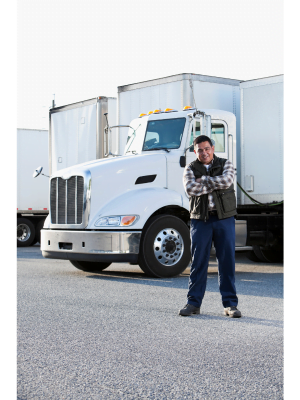What is ELDT? Your Guide to New CDL Training Standards
What is ELDT? If you want to steer your career into the commercial driving lane, understanding Entry-Level Driver Training (ELDT) is your starting point. Think of it as a crucial roadmap that lays out the essential skills and knowledge for new truck drivers.
This training isn’t just another hoop to jump through; it’s designed to ensure everyone on the road stays safe. By diving in, you’ll learn about federal requirements that impact how entry-level commercial drivers are trained before they hit the highway with big rigs or school buses.
By reading on, you’re set to get insights into who needs this training, what exemptions might apply, and why choosing an FMCSA-approved program matters for passing those critical CDL exams. Let’s shift gears together and explore everything ELDT has under its hood!

Understanding the Fundamentals of ELDT
Entry-Level Driver Training, or ELDT for short, is a new chapter in the saga of commercial driving. It’s like an educational boot camp for truckers—mandatory before they hit the road with big rigs.
Defining ELDT and Its Role in Commercial Driving
The Federal Motor Carrier Safety Administration (FMCSA) rolled out these standards to ensure new drivers aren’t just handed keys without proper training. Think about it: Would you suddenly want someone who’s never flown a plane to be at the controls? Probably not. That’s why ELDT regulations are here—to prevent that kind of scenario on our highways.
If you aim to get behind the wheel professionally, understanding what ELDT is isn’t just helpful—it’s crucial. This program ensures entry-level drivers have knowledge and skills under their belts, setting them up to pass CDL exams and excel in safety practices.
The Scope and Applicability of ELDT Requirements
Diving into who needs this training:
- New Class A or B CDL seekers are definitely on this list—they can’t dodge it.
- Gunning for endorsements like school bus (S), passenger (P), or hazardous materials (H)? You’ll need this, too.
- Lucky break if you had your CDL before February 7th, 2024—you’re off the hook since it’s not retroactive.
We’ve got specific classes and endorsements covered by these rules because, let’s face it—driving something that weighs as much as a small house requires some serious know-how.
Navigating Exemptions and Exceptions in ELDT
You might think there’s no way around federal mandates—but hold your horses. There are exceptions within FMCSA guidelines, such as exemptions listed under skills test exemptions in 49 CFR Part 383. For instance:
- Military folks with certain qualifications could bypass standard requirements—a salute to service.
- Holding onto a CLP before Feb ’22? If so, race against time; grab that CDL before your permit expires to skip extra classroom hours.
The Scope and Applicability of ELDT Requirements
So, you’re looking to hit the road with a big rig or maybe get behind the wheel of a school bus. Before you can start hauling cargo or picking up passengers, there’s this new rulebook in town: ELDT regulations. If you aim for that shiny new Class A or Class B CDL, these rules are your ticket.
Who Must Undergo Entry-Level Driver Training?
Let me explain if you’ve decided to become a commercial driver navigating those long highways. Newcomers seeking their initial Class A or B license need to check off entry-level driver training from their list as part of the FMCSA guidelines. And it doesn’t stop there; if adding endorsements like school bus (S), passenger (P), or hazardous materials (H) is on your radar – yup, you guessed it – ELDT is calling your name too.
But hold up. For all the seasoned pros who secured their CDLs before February 7th, 2024? You can breathe easily; these changes won’t knock on your door retroactively.
Navigating Exemptions and Exceptions in ELDT
All right, folks—it is time for some good news for specific individuals wearing military boots. Some military personnel might sidestep standard entry-level driver training requirements thanks to exemptions outlined under skills test exemptions in 49 CFR Part 383. But wait—that’s not all. If someone got ahead of the game with a CLP before our magic date earlier mentioned and manages to snag that coveted CDL before time runs out on their permit… no ELDT is required.
The Role of FMCSA’s Training Provider Registry in ELDT Certification
Do you want legit training? Then, say hello to FMCSA’s Training Provider Registry, where only approved providers are cut—an accurate VIP list ensuring everyone plays by federal standards.
This isn’t just about keeping tabs—it’s about guaranteeing every trucker hitting our streets has had top-notch preparation straight from certified experts recognized by none other than Uncle Sam himself through legislation known as MAP-21. Trust me when I say they don’t hand out entries into this registry like candy at Halloween—it’s earned.
Navigating Exemptions and Exceptions in ELDT
 Do you have the full scoop on Entry-Level Driver Training (ELDT)? Hold your horses because there’s a twist. Not everyone has to jump through the same hoops to hit the road with a Commercial Driver’s License (CDL). Yep, that’s right. Some lucky ducks can skip parts of the training or sidestep it altogether thanks to exemptions and exceptions built into these rules.
Do you have the full scoop on Entry-Level Driver Training (ELDT)? Hold your horses because there’s a twist. Not everyone has to jump through the same hoops to hit the road with a Commercial Driver’s License (CDL). Yep, that’s right. Some lucky ducks can skip parts of the training or sidestep it altogether thanks to exemptions and exceptions built into these rules.
If you’re military personnel with heavy vehicle experience, Uncle Sam salutes you and says “no need” for standard ELDT requirements. Now, isn’t that something? But before any vets start celebrating too soon, let me tell you—it’s not automatic. You’ve still gotta prove those driving skills translate from tank tracks to tractor-trailers.
Another group breathing easy are folks who snagged their Commercial Learner’s Permit (CLP) before February 7th, 2024. If they get their CDL before that CLP expires, they’re as good as gold—no ELDT needed. Imagine being just in time, like Indiana Jones grabbing his hat from beneath a closing stone door.
But wait, there’s more: Some drivers slide by without taking every bit of skill testing laid out in 49 CFR Part 383. That means getting behind the wheel faster than others might be possible if certain conditions apply—a neat trick up one’s sleeve.
The big takeaway is simple: While most new truckers will roll through comprehensive driver training programs designed to keep us all safe on highways, there are scenarios where different paths exist. Whether due to past experiences or good timing, these exemptions help tailor the journey toward becoming professional steering-wheel holders without compromising safety standards set by our Federal Motor Carrier Safety Administration friends.
The Role of FMCSA’s Training Provider Registry in ELDT Certification
Imagine the FMCSA’s Training Provider Registry as a backstage pass for trucking stardom—it’s where commercial driving hopefuls get verified before they can hit the road. This registry plays a pivotal role in maintaining high standards within the trucking industry, and here’s how it does its job.
Ensuring Compliance Through the Registry
The Federal Motor Carrier Safety Administration (FMCSA) doesn’t play around regarding highway safety. That’s why they set up this nifty system under MAP-21 legislation that tracks who has completed their entry-level driver training (ELDT). It ensures every new driver meets strict federal guidelines before taking control of an 18-wheeler or school bus full of kids.
To be more specific, if you’re gunning for a Class A or B CDL or maybe eyeing those shiny endorsements like school bus (S), passenger (P), or hazardous materials (H), you’ve got to train at an approved provider listed on their Training Provider Registry. Think about it—without this list, we’d have chaos with unqualified drivers doing wheelies down Main Street.
In truth, not everyone needs to worry about these requirements; some lucky ducks are exempt. Like military veterans—they’ve already proven they can handle big rigs better than most civilians ever will. And anyone who snagged their commercial learner’s permit before February 7th, 2024 gets off easy too—as long as they upgrade to full-fledged CDL status before time runs out.
But for all us regular folks? You need proof from one of these certified schools showing you know your stuff—both hands-on skills and book smarts—to even think about getting behind that big steering wheel legally. So yeah, while “registry” might sound boringly bureaucratic next to words like “truckin'” and “road warrior,” believe me: without it there’d be no ensuring only top-notch pros are manhandling those massive machines across our nation’s highways.
Preparing for Your CDL Through Registered ELDT Programs
If you’re gunning for a commercial driver’s license (CDL), there’s an essential pit stop on your road to success: completing training at a registered Entry-Level Driver Training (ELDT) provider. It’s not just any old class; it’s the law. Before you can even think about acing that skills or knowledge test, you’ve got to have this training under your belt.
Choosing the Right ELDT Training Provider
Finding the right place to learn isn’t as daunting as parallel parking an 18-wheeler—promise. Start by looking up providers listed on the FMCSA Training Provider Registry. This list is more than just names—it represents schools and programs that meet strict federal standards to keep everyone safe on the highway.
Picking a school is like picking a new pair of driving gloves—you want them to fit just right. So make sure their curriculum matches what you need, whether mastering air brakes or getting savvy with hazardous materials.
Curriculum and Content of ELDT Programs
The content in these courses isn’t pulled from thin air; it follows guidelines stricter than grandma’s curfew rules. We’re talking structured theory lessons covering everything from basic operation and maneuvering tricks through pre-trip inspections so thorough they’d impress any gearhead.
Your brain won’t be doing all the heavy lifting, either. Behind-the-wheel instruction lets drivers get hands-on experience—they don’t call them big rigs for anything.
Navigating Through The Maze Of Regulations And Requirements
The path leading up to sitting behind that massive steering wheel has some key checkpoints laid down by Uncle Sam himself—or rather, his buddies over at FMCSA (Federal Motor Carrier Safety Administration). These aren’t suggestions; if hauling cargo bigger than a breadbox is in your future, here are two things worth noting:
- You’ll need proof of completed entry-level driver training before taking those nerve-wracking tests,
- And let me tell ya, having ‘certified’ stamped next to your name after finishing one of these approved programs will shine brighter than chrome stacks at sunset.
Comparing Current and Past Commercial Driver Training Standards
The trucking world has witnessed a revolution in driver training standards with the advent of ELDT. Remember when “training” meant shadowing an old-timer for a few weeks before being thrown into the deep end? Those times are long gone, replaced by structured curricula and rigorous testing.
Enhancements Brought by New Regulations
 Gone are the wildest days when consistency in commercial driver training was as rare as rest stops with free Wi-Fi. The introduction of Entry-Level Driver Training (ELDT) marked a significant shift towards standardized education across all schools. Whether you’re eyeing that school bus endorsement or prepping to haul hazardous materials, a tailored program meeting federal requirements is waiting for you.
Gone are the wildest days when consistency in commercial driver training was as rare as rest stops with free Wi-Fi. The introduction of Entry-Level Driver Training (ELDT) marked a significant shift towards standardized education across all schools. Whether you’re eyeing that school bus endorsement or prepping to haul hazardous materials, a tailored program meeting federal requirements is waiting for you.
Prior regulations were like using paper maps—functional but cumbersome and often outdated. In contrast, modern ELDT is akin to real-time GPS navigation; it guides aspiring drivers through each critical step from theory to practice. Thanks to these updated protocols set forth by FMCSA’s Entry Level Driver Training mandate, applicants can’t just breeze through CDL exams without proving their mettle first.
To ensure this high level of competency among new drivers entering the field, ELDT includes both knowledge and behind-the-wheel instruction components — think comprehensive coursework followed up with hands-on driving under watchful eyes.
Newly minted rules don’t just spell out what needs learning but also how it should be taught. All training providers must now be listed on FMCSA’s Training Provider Registry, guaranteeing they meet specific criteria before they can mold novice wheelmen into road-ready pros.
This shift toward uniformity ensures no matter which states you call home or where your nomadic career takes you next—the skills test won’t throw curveballs outside your batting range because every player here learned from essentially the same playbook.
We’ve come far since those loosey-goosey times when ‘experience’ could mean anything from decades-long careers to mere months behind big rigs’ wheels—a testament that evolving standards aren’t regulatory hoops but strides toward safer highways for everyone sharing them.
Anticipating Future Developments in Entry-Level Driver Training
The road ahead for entry-level driver training (ELDT) is lined with technological innovation and a commitment to safety. As we steer into the future, ongoing evaluation and continuous improvement are key elements fueling the journey toward even more effective training programs.
Technology’s role in enhancing ELDT programs can’t be overstated; it’s like swapping out an old roadmap for a high-tech GPS. Simulators and virtual reality could transform how truck drivers learn, offering hands-on experience without the risk factors associated with heavy traffic or hazardous materials. This tech-driven approach aims to improve road safety and ensures that learning methods keep pace with industry advancements.
Expansions on the Horizon
Ongoing assessments might lead to expansions in curriculum requirements, especially as accident rates demand more rigorous training protocols. Imagine if every commercial driver mastered defensive driving techniques as well as they handle their morning coffee run—that’s where we’re headed. Furthermore, regular updates may refine ELDT regulations set by the Federal Motor Carrier Safety Administration (FMCSA), ensuring that each new generation of drivers is better equipped than the last.
New developments could see specializations within CDL endorsements receive greater focus during training sessions—knowing how to secure cargo effectively can be just as crucial as navigating through rush hour traffic safely. By continuously polishing these educational standards, everyone from seasoned veterans to fresh-faced recruits stands to benefit significantly.
Road Map for Continuous Improvement
To ensure no pothole goes unfixed along this educational highway, expect periodic reviews of the effectiveness of entry-level driver education programs in reducing incidents on our roads—the ultimate gauge of success. These aren’t just arbitrary changes but carefully planned enhancements akin to scheduled vehicle maintenance checks designed for optimal performance over time.
Institutions providing such instruction will also remain scrutinized; think of FMCSA’s Training Provider Registry as quality control, guaranteeing providers meet or exceed federal rules before handing them keys to train tomorrow’s fleet operators. And let’s not forget about those completing their certifications—it’ll take robust tracking systems coupled with ironclad certification processes before learners exchange their permit for a shiny new CDL license plate.
Maximizing Benefits From Comprehensive Entry-Level Driver Education Programs
The trucking industry thrives on the expertise of its drivers, and nothing lays a better foundation than comprehensive entry-level driver education programs. These educational powerhouses are more than just stepping stones; they’re launchpads for career growth that benefit Greenhorn drivers and seasoned road veterans.
Benefits for New Truck Drivers
Fresh-faced drivers get to cut their teeth on foundational knowledge through these programs, giving them a solid grasp of safety regulations set by experts in motor carrier safety administration. It’s not just about gripping the wheel tighter; it’s about understanding the rules of the road inside-out, which ELDT mandates ensure. With every page turn or click in an online module, rookies absorb critical information to keep everyone safe.
ELDT isn’t some rickety bridge to cross into truck driving—it’s akin to getting handed the keys to a robust 18-wheeler full of skills and know-how. The training requirements aren’t hurdles but rather building blocks that create confident commercial learners ready to handle anything from hazardous materials to transportation*.
Gains for Seasoned Professionals
Veteran truckers might ask, “What’s in it for me?” Plenty. Imagine professional development being treated like upgrades on your favorite rig—each enhancement fine-tuning performance. Experienced truck drivers who dive back into education can expect their already sharp skills honed even further with updates on federal rules and practices within specialized niches like school bus operations or hazardous material handling.
This continuous learning loop doesn’t just buff up individual careers; employers reap the rewards because well-trained employees drive efficiency sky-high, meaning fewer mishaps and smoother logistics*. When you invest time into completing such training certified by FMCSA-approved providers, you’re polishing your value alongside improving overall community standards.
*Data reflects key statistics noted regarding enhancements provided by modernized training protocols compared with older methods.
FAQs
What does ELDT stand for?
ELDT is shorthand for Entry-Level Driver Training, the new must-do schooling before truckers hit the highway.
Is an ELDT required in California?
Sure thing. Trucking rookies in California must tackle ELDT like everywhere else in the US.
